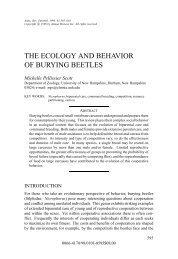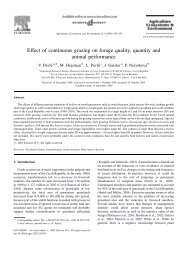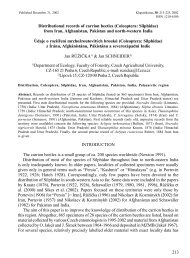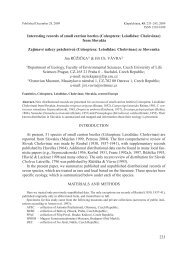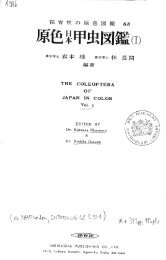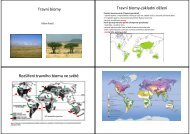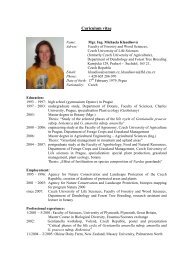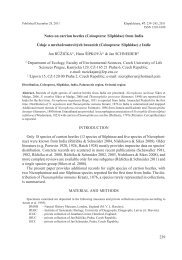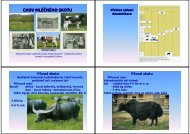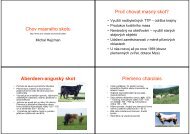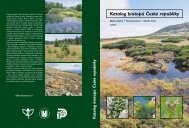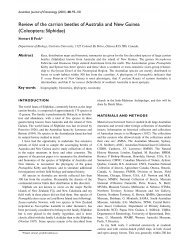<strong>ZOOTAXA</strong>65Riha, P. (1949) Nova odchylka hrobarika Necrophorus interruptus Steph. Nova aberratio specieiNecrophorus interruptus Steph. (Col., Silphidae). Acta Societatis Entomologicae Cechosloveniae,46, 133. (description in Czech) [Description of 1 aberrational unavailable name.]Rivera-Cervantes, L.E. & García-Real, E. (1998) Analisis preliminar sobre la composición de losexcarabajos necrófilos (Coleoptera: Silphidae y Scarabaeidae) presentes en dos bosques depino (uno dañada por fuego), en la Estación Científica Las Joyas, Sierra de Manantlán, Jalisco,México. Dugesiana, 5 (1), 11-22. (biology, ecology in Spanish) [!N]Roberts, R.A. (1933) Activity of blowflies and associated insects at various heights above theground. Ecology, 14(3), 306-314. (comment: ecology) [Lists N. marginatus as among the bottom1% of predators on blowflies.] [!S]Robertson, I.C. (1992) Relative abundance of Nicrophorus pustulatus (Coleoptera: Silphidae) in aburying beetle community, with notes on its reproductive behavior. Psyche (Cambridge, Massachusetts),99(2-3), 189-197. (biology, ecology) [In lab N. pustulatus bred more efficiently onsmall carcasses than N. orbicollis.] [!S]Robertson, I.C. (1993) Nest intrusions, infanticide, and parental care in the burying beetle, Nicrophorusorbicollis (Coleoptera: Silphidae). Journal of Zoology (London), 231(4), 583-593.(biology, behavior) [First study to demonstrate that usurpers destroy resident eggs.] [!S]Robertson, I.C. (1995) [“1994”] Extra-pair copulations in burying beetles (Coleoptera: Silphidae).Journal of the Kansas Entomological Society, 67(4), 418-420. (biology, behavior) [Half of thefemales were inseminated by parental males of N. orbicollis, but none were inseminated by N.pustulatus.] [!S]Robertson, I.C., Robertson, W.G., & Roitberg, B.D. (1998) A model of mutual tolerance and theorigin of communal associations between unrelated females. Journal of Insect Behavior, 11(2),265-286. (biology, behavior) [Model to predict patterns of communal behavior.] [!N]Robertson, J.G. (1961) Ovariole numbers in Coleoptera. Canadian Journal of Zoology, 39, 245-263. (morphology: ovaries) [References Stein 1847 -primary source for silphid ovariole numbers][!N, S]Roehrich, C. (1949) Notes sur les nécrophores dans le bocage normand. Entomologiste, 5, 44-45.(biology, ecology in French) [!N]Roemer, J. J. (1789) Genera Insectorum Linnei et Fabricii iconibus illustrata. Vitoduri, Steiner; 4.1-86 pp. (catalog)Rohner, C. (1990) Resource partitioning and interspecific competition in burying beetles Necrophorus(Coleoptera, Silphidae) in the Lake Zurich Area. Revue Suisse de Zoologie, 97(2), 453-464.(biology, ecology in German (English summary)) [!S]Rösel von Rosenhof, A.J. (1761) Der monathlich-herausgegebenen Insecten-Belustigung vierterTheil. Nurnberg, 1761-76. 376p pp. 1-20. (biology, behavior in German) [Cited by Pukowski(1933) as one of the earlier observations on Nicrophorus behaviors]Rosenhauer, W.G. (1847) Beiträge zur Insekten-Fauna Europas. Erstes Bändchen, enthält die Beschreibungvon sechzig neuen Käfern aus Bayern, Tyrol, Ungarn etc., so wie die Käfer Tyrols,nach dem Ergebnisse von vier Reisen. T. Blaesing, Erlangen. x + 159 pp., 1 pl. (checklist inGerman) [!N]Rossi, P.D. (1790) Fauna Etrusca: sistens Insecta quae in provinciis Florentina et Pisana praesertimcollegit petrus Rossius. Liburni: Typis Thomae Masi & Sociorum pp. xxii-350.Roubal, J. (1913) Koleopterologisch-oekologische Skizzen. Casopis Ceské Spolecnosti Entomologické,10, 121-123. (biology, ecology in Czech & German)Roubal, J. (1915) Vier Coleopteren-Neuheiten. Entomologische Blätter, 11, 169-171. (descriptionof variation in German)Roubal, J. (1924) Einige Käferneuheiten. Entomologischer Anzeiger, 4, 80-81. (description of variationin German)282 © 2002 Magnolia PressSIKES ET AL.
Roubal, J. (1930) [“1930-1936”] Katalog coleopter (Brouku) slevenska a podkarpatske Rusi nazaklade bionomickém a zoogeografickém a spolu systematicky doplnek Gangelbauerovych"Die Kafer von Mitteleuropa" a Reitterovy "Fauna germanica". Catalogue des coléoptères dela slovaquie et de la Russie subcarpathique d'après les documents bionomiques etzoogéographiques ainsi que supplement systématique au Ganglbauer, Die Käfer von Mitteleuropaet Reitter, Fauna germanica. Praha, Nákladem Ucené spolecnosti safaríkovy v Bratislavevytiskla státní tiskarna v Praze (catalog in Czech) [!S]Roubal, J. (1934) Beschreibung zweier neuer Coleopteren nebst Bemerkungen. Folia Zoologica etHydrobiologica, 5, 323-325. (description of variation in German) [short paragraph on a variantof N. vespilloides.] [!S]Roubal, J. (1939) Necrophorus vespillo L. v. bohemicus n. Acta Societatis Entomologicae Bohemiae,36, 85-86. (description of variation in Czech (French summary)) [Original description ofN. vespillo var. bohemicus (=N. vespillo).] [!S]Roubal, J. (1942) O nekolika nasich hrobarících. De nonnullis nostris Necrophoris. Acta SocietatisEntomologicae Bohemiae, 39, 17. (description of variation in Czech) [one page description ofnew forms (aberrations) of European Nicrophorus.] [!S]Roussel, J.-P. (1963) Conditions de reprise de líactivité et de la reproduction chez Necrophorusvespillo L. en état díhibernation. Bulletin de la Société Zoologique de France, 88, 671-673.(biology, ecology, behavior in French)Roussel, J.-P. (1964a) Le développement larvaire de Necrophorus vespillo L. Bulletin de la SociétéZoologique de France, 89, 102-110. (morphology, larval stages in French) [!N]Roussel, J.-P. (1964b) Le développement larvaire de Necrophorus fossor Er. Bulletin de la SociétéZoologique de France, 89, 111-117. (morphology, larval stages in French) [!N]Roussel, J.-P. (1965a) Recherches sur la diapause de Necrophorus fossor Er. Bulletin de la SociétéZoologique de France, 90, 67-88. (morphology, larval stages in French (English summary))Roussel, J.-P. (1965b) Recherches experimentales sur la diapause de Necrophorus fossor Er.Comptes Rendus de líAcademie des Sciences, (D) 6452-6454. (morphology, larval stages inFrench)Rozner, I. (1981) Data to the Silphidae (Coleoptera) fauna of the Hortobágy National Park. NaturalHistory of the National Parks of Hungary, 1, 103-104. (checklist in Hungarian) [!N]Runtz, M.W.P. & Peck, S.B. (1994) The beetle fauna of a mature spruce-sphagnum bog, AlgonquinPark, Ontario; ecological implications of the species composition. Memoirs of the EntomologicalSociety of Canada, 169, 161-171. (biology, ecology) [!N]RÉÓigka, J. (1992) The immature stages of central European species of Nicrophorus (Coleoptera,Silphidae). Acta Entomologica Bohemoslovaca, 89(2), 113-135. (key, descriptions, morphology,larval stages, phylogenetics) [Excellent illustrations and descriptions of European larvalstages; follows phylogenetics of Anderson 1982a, but polarity of one character is changed.][!S]RÉÓigka, J. (1993) Agyrtidae, Silphidae, pp. 33-34. In: J. Jelínek (ed.), Check-list of Czechoslovakinsects, IV (Coleoptera). Folia Heyrovskyana Supplementum, 1, 1-172. (checklist, distributionin English & Czech) [!N]RÉÓigka, J. (1994) Seasonal activity and habitat associations of Silphidae and Leiodidae: Cholevinae(Coleoptera) in central Bohemia. Acta Societatis Zoologicae Bohemoslovicae, 58, 67-78.(biology, ecology) [All Nicrophorus spp. but N. vespillo were common in forests. N. vespillowas more common in fields.] [!N, S]RÉÓigka, J. (1996) Results of the Czechoslovak-Iranian entomological expeditions to Iran.Coleoptera: Silphidae. Klapalekiana, 32(1-2), 73-75. (checklist) [First reliable records for N.vespilloides & N. investigator from Iran are provided.] [!S]<strong>ZOOTAXA</strong>65CATALOG OF NICROPHORINAE© 2002 Magnolia Press 283
- Page 7 and 8:
HistoryLinnaeus named two species o
- Page 10 and 11:
ZOOTAXA65nomina nuda, misspellings,
- Page 12 and 13:
ZOOTAXA65AcknowledgementsThis proje
- Page 14 and 15:
ZOOTAXA65Available species group na
- Page 18 and 19:
ZOOTAXA peruvianus Pic, 1917; as va
- Page 20 and 21:
ZOOTAXA plagiatipennis Lewis, 1879;
- Page 22 and 23:
ZOOTAXA 1790 Olivier: no. 10, p. 6
- Page 24 and 25:
ZOOTAXA 1989 Kozol: 1-10 (biology,
- Page 26 and 27:
ZOOTAXA 1868 Gemminger & Harold: 71
- Page 28 and 29:
ZOOTAXA 1970 Franz: 213 (checklist,
- Page 30 and 31:
ZOOTAXA 1933 Semenov-Tian-Shanskij:
- Page 32 and 33:
ZOOTAXA 1895b Reitter: 326 (descrip
- Page 34 and 35:
ZOOTAXA 1986 Anderson & Peck: 283 (
- Page 36 and 37:
ZOOTAXA65Florida. The melanic popul
- Page 38 and 39:
ZOOTAXA 1986 Cho & Lee: 20 (phyloge
- Page 40 and 41:
ZOOTAXA65N. confusus and N. sepulto
- Page 42 and 43:
ZOOTAXA 1884 Marseul: 185 (key, des
- Page 44 and 45:
ZOOTAXA 1990 Peck: 1123 (key)651990
- Page 46 and 47:
ZOOTAXA 1870 Motschulsky: 352 (desc
- Page 48 and 49:
ZOOTAXA = flexuosus Portevin,192465
- Page 50 and 51:
ZOOTAXA 1761 Sulzer: pl. 2, fig. 10
- Page 52 and 53:
ZOOTAXA 1889 Fowler: 43 (descriptio
- Page 54 and 55:
ZOOTAXA 1983 Putman: 38-42 (biology
- Page 56 and 57:
ZOOTAXA 2002 Nikolajev & Kozminykh:
- Page 58 and 59:
ZOOTAXA 1895b Reitter: 324 (descrip
- Page 60 and 61:
ZOOTAXA 1884 Marseul: 184 (key, des
- Page 62 and 63:
ZOOTAXA 1930 Roubal: 240 (catalog i
- Page 64 and 65:
ZOOTAXA 1910 Barkowski: 80 (key, de
- Page 66 and 67:
ZOOTAXA 1928 Hatch: 130 (catalog)65
- Page 68 and 69:
ZOOTAXA 1870 Vollenhoven et al.: 54
- Page 70 and 71:
ZOOTAXA 1939 Lengerken: 263 (biolog
- Page 72 and 73:
ZOOTAXA 1986 Nishikawa: 99 (catalog
- Page 74 and 75:
ZOOTAXA 1909 Bickhardt: 75 (descrip
- Page 76 and 77:
ZOOTAXA Nicrophorus hybridus Hatch
- Page 78 and 79:
ZOOTAXA65“PARALECTOTYPE Nicrophor
- Page 80 and 81:
ZOOTAXA 1944 Arnett: 7 (morphology:
- Page 82 and 83:
ZOOTAXA 1882 Gradl: 331 (descriptio
- Page 84 and 85:
ZOOTAXA 1993b Kozminykh: 65 (key, d
- Page 86 and 87:
ZOOTAXA 1965b Roussel: 6452 (morpho
- Page 88 and 89:
ZOOTAXA 1926a Portevin: 257 (revisi
- Page 90 and 91:
ZOOTAXA = pasqueti Pic, 1917 NEW ST
- Page 92 and 93:
ZOOTAXA65Lectotype data for Nicroph
- Page 94 and 95:
ZOOTAXA 1891 Heyden et al.: 138 (ch
- Page 96 and 97:
ZOOTAXA 1971 Freude: 194 (key in Ge
- Page 98 and 99:
ZOOTAXA 1995 Kozminykh: 110 (key in
- Page 100 and 101:
ZOOTAXA65Type depository: MCZC: Cam
- Page 102 and 103:
ZOOTAXA 1868 Gemminger & Harold: 71
- Page 104 and 105:
ZOOTAXA 1925 Winkler: 264 (catalog)
- Page 106 and 107:
ZOOTAXA65Type depository: MZHF: Hel
- Page 108 and 109:
ZOOTAXA 1866 Marseul: 38 (catalog i
- Page 110 and 111:
ZOOTAXA 1926a Portevin: 222 (revisi
- Page 112 and 113:
ZOOTAXA 1866 Michow: 411 (descripti
- Page 114 and 115:
ZOOTAXA 1899 Ganglbauer: 164 (descr
- Page 116 and 117:
ZOOTAXA65from reduced to absent, bu
- Page 118 and 119:
ZOOTAXA Paralectotype data “17/67
- Page 120 and 121:
ZOOTAXA Nicrophorus maculifrons Kra
- Page 122 and 123:
ZOOTAXA 1955b Nakane: 54 (key, desc
- Page 124 and 125:
ZOOTAXA 1911 Wickham: 10 (checklist
- Page 126 and 127:
ZOOTAXA 2000 Sikes & Peck: 395 (des
- Page 128 and 129:
ZOOTAXA65with the elytral fascia sh
- Page 130 and 131:
ZOOTAXA 1975a Emetz: 60 (checklist
- Page 132 and 133:
ZOOTAXA65border “LECTOTYPE Nicrop
- Page 134 and 135:
ZOOTAXA 1992 Kozminykh: 64 (checkli
- Page 136 and 137:
ZOOTAXA 1879 Dohrn: 459 (comment in
- Page 138 and 139:
ZOOTAXA Nicrophorus nigricornis Fal
- Page 140 and 141:
ZOOTAXA 1920 Leng: 86 (catalog) >>
- Page 142 and 143:
ZOOTAXA 1925 Winkler: 264 (catalog)
- Page 144 and 145:
ZOOTAXA65Type depository: BMNH: Lon
- Page 146 and 147:
ZOOTAXA 1933 Wolcott & Montgomery:
- Page 148 and 149:
ZOOTAXA 1994 Beninger: 135-143 (bio
- Page 150 and 151:
ZOOTAXA Nicrophorus podagricus Port
- Page 152 and 153:
ZOOTAXA 1999 Háva et al.: 76 (key,
- Page 154 and 155:
ZOOTAXA 1982c Anderson: 1316 (biolo
- Page 156 and 157:
ZOOTAXA Nicrophorus quadraticollis
- Page 158 and 159:
ZOOTAXA 1933 Semenov-Tian-Shanskij:
- Page 160 and 161:
ZOOTAXA 1994a Ôhara: 58 (checklist
- Page 162 and 163:
ZOOTAXA 1895b Reitter: 324 (descrip
- Page 164 and 165:
ZOOTAXA 1985 Peck & Anderson: 287 (
- Page 166 and 167:
ZOOTAXA Nicrophorus scrutator Blanc
- Page 168 and 169:
ZOOTAXA 1859 Schaum: 36 (catalog in
- Page 170 and 171:
ZOOTAXA 1849 Bach: 153 (checklist,
- Page 172 and 173:
ZOOTAXA 1980 Franssen: 46 (morpholo
- Page 174 and 175:
ZOOTAXA 1887 Lewis: 341 (descriptio
- Page 176 and 177:
ZOOTAXA65139.48°E,]19-24 August 18
- Page 178 and 179:
ZOOTAXA 1970 Gersdorf: 366 (morphol
- Page 180 and 181:
ZOOTAXA 1998b Scott: 598+ (biology,
- Page 182 and 183:
ZOOTAXA 1944 Arnett: 5 (morphology:
- Page 184 and 185:
ZOOTAXA 1761 Rösel von Rosenhof: 2
- Page 186 and 187:
ZOOTAXA 1873 Klika: 127 (checklist
- Page 188 and 189:
ZOOTAXA 1939 Székessy: 943 (morpho
- Page 190 and 191:
ZOOTAXA 1987 Jensen: 116 (biology,
- Page 192 and 193:
ZOOTAXA 1881 Westhoff: 108 (descrip
- Page 194 and 195:
ZOOTAXA65Type depository: LNMD: Mü
- Page 196 and 197:
ZOOTAXA 1888 Seidlitz: 313 (key in
- Page 198 and 199:
ZOOTAXA 1948 Clark: 27 (checklist)6
- Page 200 and 201:
ZOOTAXA 1982 Wisiniewski (biology,
- Page 202 and 203:
ZOOTAXA 1993 RÉÓigka: 34 (checkli
- Page 204 and 205:
ZOOTAXA = aurora Motschulsky, 1860
- Page 206 and 207:
ZOOTAXA 1937 Leech: 156 (nomenclatu
- Page 208 and 209:
ZOOTAXA 1885 Marseul: 169 (catalog
- Page 210 and 211:
ZOOTAXA 1937 Leech: 156 (nomenclatu
- Page 212 and 213:
ZOOTAXA Nicrophorus vestigator Hers
- Page 214 and 215:
ZOOTAXA 1922 Sherborn: 6882 (catalo
- Page 216 and 217:
ZOOTAXA65Spanish)2002 Nikolajev & K
- Page 218 and 219:
ZOOTAXA 1902 Heyden: 12 (nomenclatu
- Page 220 and 221:
ZOOTAXA = olfactor Gistel, 1848 NEW
- Page 222 and 223:
ZOOTAXA PTOMASCOPUS Kraatz, 1876: 3
- Page 224 and 225:
ZOOTAXA65Type depository: BMNH: Lon
- Page 226 and 227:
ZOOTAXA 1925 Winkler: 265 (catalog)
- Page 228 and 229:
ZOOTAXA Ptomascopus zhangla Háva,
- Page 230 and 231:
ZOOTAXA65ReferencesAbbott, C.E. (19
- Page 232 and 233: ZOOTAXA65nepalensis are more closel
- Page 234 and 235: ZOOTAXA65Bedick, J.C. (1997) Distri
- Page 236 and 237: ZOOTAXA65Blanchard, É. (1842) Inse
- Page 238 and 239: ZOOTAXA65description of N. didymus.
- Page 240 and 241: ZOOTAXA65Conley, M.R. (1982) Carrio
- Page 242 and 243: 65ZOOTAXA Delahon, P. (1913) Nachtr
- Page 244 and 245: ZOOTAXA65Eisfelder, I. (1963) Käfe
- Page 246 and 247: ZOOTAXA65Faldermann, F. (1835a) Add
- Page 248 and 249: ZOOTAXA65Gaubil, J. (1849) Catalogu
- Page 250 and 251: ZOOTAXA65Gwiazdowicz, D.J. (2000) M
- Page 252 and 253: ZOOTAXA65Hausmann, J.F.L. (1799) En
- Page 254 and 255: ZOOTAXA65Hlisnikovsky, J. (1942) Co
- Page 256 and 257: ZOOTAXA65Jakovlev, B.E. (1887) Col
- Page 258 and 259: ZOOTAXA65Kirby, W. & Spence, W. (18
- Page 260 and 261: ZOOTAXA65Kozminykh, V.O. (1997) Fau
- Page 262 and 263: ZOOTAXA65Labitte, A. (1916) Longév
- Page 264 and 265: ZOOTAXA65Lindroth, C.H. & Ball, G.E
- Page 266 and 267: 65ZOOTAXA Marseul, S.-A. (1866) Cat
- Page 268 and 269: ZOOTAXA65Miller, S.E. & Miller, P.M
- Page 270 and 271: ZOOTAXA65Müller, J.K. & Dressel, J
- Page 272 and 273: ZOOTAXA65Newman, E. (1838) Entomolo
- Page 274 and 275: ZOOTAXA65Opler, P.A. [ed.] (1985) S
- Page 276 and 277: ZOOTAXA65Peck, S.B. & Miller, S.E.
- Page 278 and 279: ZOOTAXA65Portevin, G. (1914a) Silph
- Page 280 and 281: ZOOTAXA65Ranson, J. (1864) Fecundit
- Page 284 and 285: ZOOTAXA65RÉÓigka, J. (1999) Beetl
- Page 286 and 287: ZOOTAXA65Schneider, P. (1978) Die F
- Page 288 and 289: ZOOTAXA65Schweitzer, D.F. & Master,
- Page 290 and 291: 65ZOOTAXA (revision: key, descripti
- Page 292 and 293: ZOOTAXA65Smith, R.J., Hines, A., Ri
- Page 294 and 295: ZOOTAXA65Stroud, C.P. (1950) A surv
- Page 296 and 297: ZOOTAXA65Trumbo, S.T. (1990b) Repro
- Page 298 and 299: ZOOTAXA65Walkden, H.H. (1944) Insec
- Page 300 and 301: ZOOTAXA65Xambeu, P. (1892) Moeurs e
- Page 302 and 303: ZOOTAXA65Index (continued)Nicrophor
- Page 304: ZOOTAXA65Index (continued)Nicrophor



